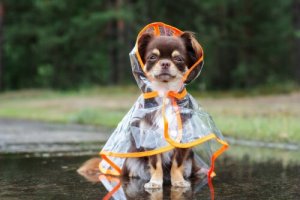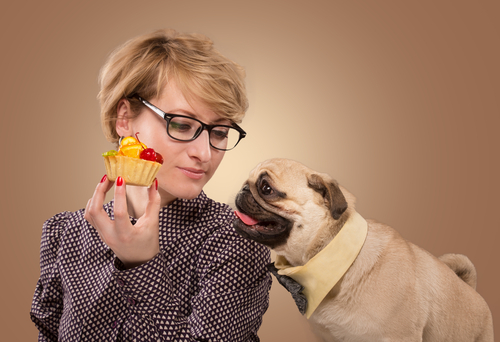How to Protect your Dog from the Cold Winter Weather


Written and verified by the biologist Paloma de los Milagros
Just like with humans, the cold winter weather can be dangerous for your pet’s health. It’s therefore essential to protect your pet from extreme weather conditions.
Dogs are the pets that are the most likely to be exposed to the cold winter weather, their daily walks leaving them vulnerable to colds and more serious lung infections. However, not all breeds need the same level of protection; small and short-coated breeds are the most at risk.
In this article, we’ll give you some veterinary-recommended advice for keeping your pet safe in the cold winter weather.
Walking your dog in the cold winter weather
- Avoid sudden changes in temperature. Normally, owners take their pets outside without considering how drastically the temperatures differ from their warm, centrally-heated homes. So, before you take your dog for a walk, it’s good to turn down the heating for a while. That way, there won’t be such a huge difference in temperature.
- Wrap your pet up warm. A physical barrier against the wind, rain, and cold is the most effective way to protect your pet against adverse weather conditions. However, it’s important to mention that the majority of the hats, socks and other items you’ll find in pet stores are designed purely as fashion accessories. Not only will they be ineffective against the cold, but they can also be uncomfortable for your pet.
- Wash and dry your dog thoroughly after every walk. Regardless of any protective clothing you put on your pet, they will almost certainly get damp, especially the fur around their legs and face. Removing any traces of mud and moisture is essential for preventing sickness and sores.

Keeping your dog healthy in winter
- Avoid or reduce direct contact with snow. Spending long periods of time standing or walking on frozen surfaces can hurt the pads of their feet. Plus, you’ll need to make sure your pet doesn’t ingest large amounts of snow, as it can cause indigestion.
- Keep them warm in the house. Dressing your dog in a coat and keeping it away from drafts are good ways to keep your pet happy and healthy. Although your animal will undoubtedly move around from time to time, they tend to be less active when they’re alone or when the weather conditions are particularly severe. Keeping them wrapped up warm is a good way to make sure they don’t get too cold in the house.
- Make sure they are up-to-date on their vaccinations. Just like any other time of the year, it’s important to make sure your pet has had all its vaccinations. While many owners mistakenly believe that it is only necessary in summer, you’ll also need to continue treating your pet with antiparasitics.
- Maintain a healthy, balanced diet. Because they generally burn more energy during the cold winter months, owners often find their pets ask for more food. However, because the cold weather also coincides with the festive period, many owners tend to be more “flexible” when it comes to feeding their pets, without really thinking about the digestive issues that can result from this sudden change of diet.

Risk factors and symptoms
As a general rule, small, short-coated dogs are the most sensitive to the cold. However, it’s important to mention that age is also a key factor. Puppies and older dogs are most susceptible to infections and disease.
Some of the symptoms that will help you recognize when your pet is feeling the cold include: shaking or shivering, excessive drowsiness, a dry nose or flaky skin.
So, if it’s impossible for you to avoid walking your dog during the coldest hours of the day, you’ll need to take preventative measures to keep your pet safe.
Just like with humans, the cold winter weather can be dangerous for your pet’s health. It’s therefore essential to protect your pet from extreme weather conditions.
Dogs are the pets that are the most likely to be exposed to the cold winter weather, their daily walks leaving them vulnerable to colds and more serious lung infections. However, not all breeds need the same level of protection; small and short-coated breeds are the most at risk.
In this article, we’ll give you some veterinary-recommended advice for keeping your pet safe in the cold winter weather.
Walking your dog in the cold winter weather
- Avoid sudden changes in temperature. Normally, owners take their pets outside without considering how drastically the temperatures differ from their warm, centrally-heated homes. So, before you take your dog for a walk, it’s good to turn down the heating for a while. That way, there won’t be such a huge difference in temperature.
- Wrap your pet up warm. A physical barrier against the wind, rain, and cold is the most effective way to protect your pet against adverse weather conditions. However, it’s important to mention that the majority of the hats, socks and other items you’ll find in pet stores are designed purely as fashion accessories. Not only will they be ineffective against the cold, but they can also be uncomfortable for your pet.
- Wash and dry your dog thoroughly after every walk. Regardless of any protective clothing you put on your pet, they will almost certainly get damp, especially the fur around their legs and face. Removing any traces of mud and moisture is essential for preventing sickness and sores.

Keeping your dog healthy in winter
- Avoid or reduce direct contact with snow. Spending long periods of time standing or walking on frozen surfaces can hurt the pads of their feet. Plus, you’ll need to make sure your pet doesn’t ingest large amounts of snow, as it can cause indigestion.
- Keep them warm in the house. Dressing your dog in a coat and keeping it away from drafts are good ways to keep your pet happy and healthy. Although your animal will undoubtedly move around from time to time, they tend to be less active when they’re alone or when the weather conditions are particularly severe. Keeping them wrapped up warm is a good way to make sure they don’t get too cold in the house.
- Make sure they are up-to-date on their vaccinations. Just like any other time of the year, it’s important to make sure your pet has had all its vaccinations. While many owners mistakenly believe that it is only necessary in summer, you’ll also need to continue treating your pet with antiparasitics.
- Maintain a healthy, balanced diet. Because they generally burn more energy during the cold winter months, owners often find their pets ask for more food. However, because the cold weather also coincides with the festive period, many owners tend to be more “flexible” when it comes to feeding their pets, without really thinking about the digestive issues that can result from this sudden change of diet.

Risk factors and symptoms
As a general rule, small, short-coated dogs are the most sensitive to the cold. However, it’s important to mention that age is also a key factor. Puppies and older dogs are most susceptible to infections and disease.
Some of the symptoms that will help you recognize when your pet is feeling the cold include: shaking or shivering, excessive drowsiness, a dry nose or flaky skin.
So, if it’s impossible for you to avoid walking your dog during the coldest hours of the day, you’ll need to take preventative measures to keep your pet safe.
All cited sources were thoroughly reviewed by our team to ensure their quality, reliability, currency, and validity. The bibliography of this article was considered reliable and of academic or scientific accuracy.
- RoyalCanin. Cuidados invernales. (s.f). Recuperado de https://www.royalcanin.es/cuidados-invernales
- RoyalCanin. Cómo cuidar de mi perro cuando hace frío. (2014). Recuperado de https://www.royalcanin.es/como-cuidar-de-mi-perro-cuando-hace-frio
This text is provided for informational purposes only and does not replace consultation with a professional. If in doubt, consult your specialist.








